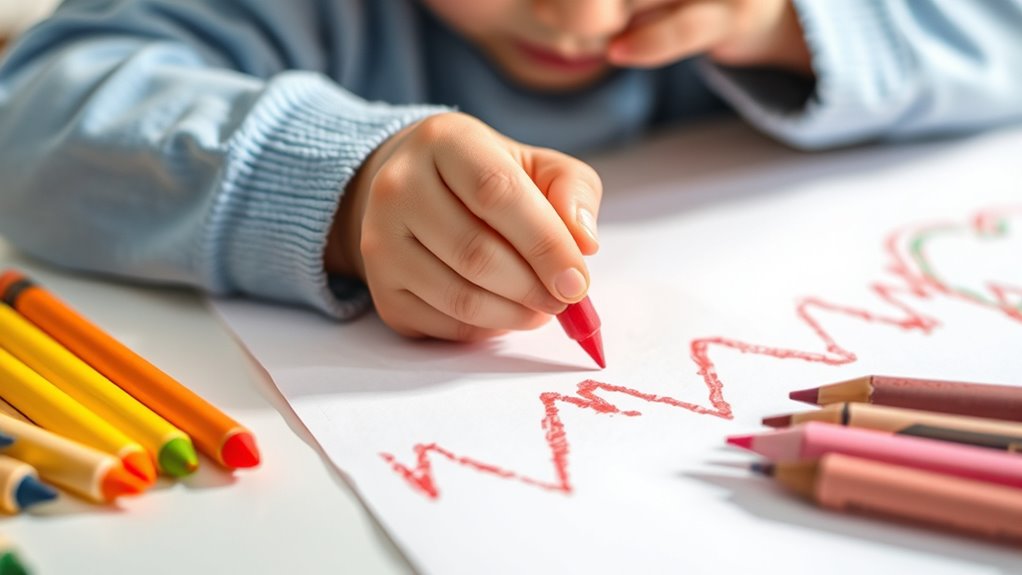To develop your child’s fine motor milestones through play, focus on activities that strengthen finger grasp, such as picking up small objects and sorting by color. Encourage sensory play to boost tactile awareness, and use drawing or coloring to improve hand coordination. Puzzles and stacking blocks help refine bilateral control. By consistently engaging in these playful exercises, you set a strong foundation for successful pre-writing skills—continue exploring ways to support their progress.
Key Takeaways
- Engaging in play with small objects like beads and buttons enhances finger strength and grasp skills essential for pre-writing.
- Sensory activities improve tactile awareness, supporting better hand control and coordination necessary for writing.
- Drawing, coloring, and scribbling help develop hand-eye coordination and refine fine motor movements.
- Puzzles and stacking activities promote bilateral hand coordination and purposeful hand movements.
- Consistent play-based practice builds foundational skills, making handwriting more natural and effortless over time.

Developing pre-writing skills is an essential step in your child’s early learning journey, and one of the most effective ways to do this is through play. When you engage your child in activities that promote finger grasp and hand coordination, you’re helping them build a strong foundation for writing. These skills are necessary because they enable your child to hold a pencil properly, control their movements, and form recognizable shapes and letters in the future. Play-based activities make these developmental steps enjoyable, encouraging your child to practice and improve without feeling pressured.
Start by encouraging activities that strengthen finger grasp, such as picking up small objects like beads, buttons, or pom-poms. These tasks require your child to use their fingertips, developing the fine motor control needed for writing. You can turn this into a game by asking them to sort objects by color or size, which not only makes it fun but also promotes precise finger movements. As they grasp and release objects repeatedly, their finger muscles become stronger and more dexterous, laying the groundwork for more complex hand movements. Additionally, understanding sensory development can help tailor activities that enhance tactile awareness and fine motor skills.
Encourage small object play to boost finger strength and refine fine motor skills for writing success.
Hand coordination is equally important and can be developed through activities that require controlling both hands simultaneously. For example, give your child crayons, markers, or chalk to scribble on paper or sidewalk surfaces. As they hold the writing instrument with a proper grip, they learn to coordinate their hand movements. You can also introduce simple puzzles or stacking blocks, which require your child to use one hand to hold pieces while the other manipulates them, enhancing bilateral coordination. These activities help your child learn how to guide their hand with intention and control, skills that are essential when they begin to draw or write letters.
Frequently Asked Questions
When Should I Start Introducing Pre-Writing Activities to My Child?
You should start introducing pre-writing activities to your child around age 3. Focus on early literacy activities and hand-eye coordination exercises, like drawing, tracing, and playing with crayons. These activities help develop the skills needed for writing. Keep it fun and engaging, and gradually increase complexity as your child’s skills improve. This approach prepares them for more advanced writing tasks while supporting their overall fine motor development.
How Can I Tell if My Child Is Developmentally Ready for Pre-Writing Skills?
Like a well-tuned musical instrument, your child’s readiness for pre-writing skills hinges on certain signs. Look for consistent hand dominance and good visual tracking, which show they’re developing fine motor control. If they can grasp small objects, imitate strokes, and coordinate their hand movements smoothly, they’re likely ready. When you see these skills emerging, it’s a clear signal it’s time to gently introduce pre-writing activities and foster their fine motor growth.
Are There Specific Toys That Effectively Promote Fine Motor Development?
You should look for toy recommendations that target fine motor development, like small building blocks, puzzles, and shape sorters, which encourage grasping, pinching, and hand-eye coordination. These toys align with developmental milestones, helping your child improve finger strength and dexterity essential for pre-writing skills. Engage actively by encouraging your child to manipulate these toys, making play both fun and educational, and supporting their progress toward future writing abilities.
How Can I Encourage My Child to Persevere Through Challenging Tasks?
To help your child persevere through challenging tasks, use persistence strategies like breaking tasks into smaller steps and celebrating progress. Encourage them with positive reinforcement and patience, showing that effort matters more than immediate success. Share stories of overcoming difficulties and offer consistent encouragement techniques, such as praising their effort and resilience. This approach builds confidence, motivates continued effort, and teaches them that persistence leads to achievement.
What Are Signs My Child Might Need Additional Fine Motor Support?
If your child’s handwriting struggles seem to take forever or look like a secret code, they might need extra fine motor support. Watch for difficulty gripping pencils, frequent fatigue, or a lack of coordination in small tasks. A fine motor assessment can reveal if they need targeted help. Don’t wait—early intervention can turn those tiny tremors into confident, legible writing.
Conclusion
As you nurture your child’s fine motor skills through playful activities, you’re planting seeds that will grow into a strong foundation for writing. Think of play as the gentle wind guiding a sailboat, helping it navigate toward success. With patience and encouragement, you’ll see your little one sail smoothly into those pre-writing milestones, turning the journey into an enjoyable adventure. Keep playing, and watch their confidence and skills blossom like a beautiful garden in full bloom.









